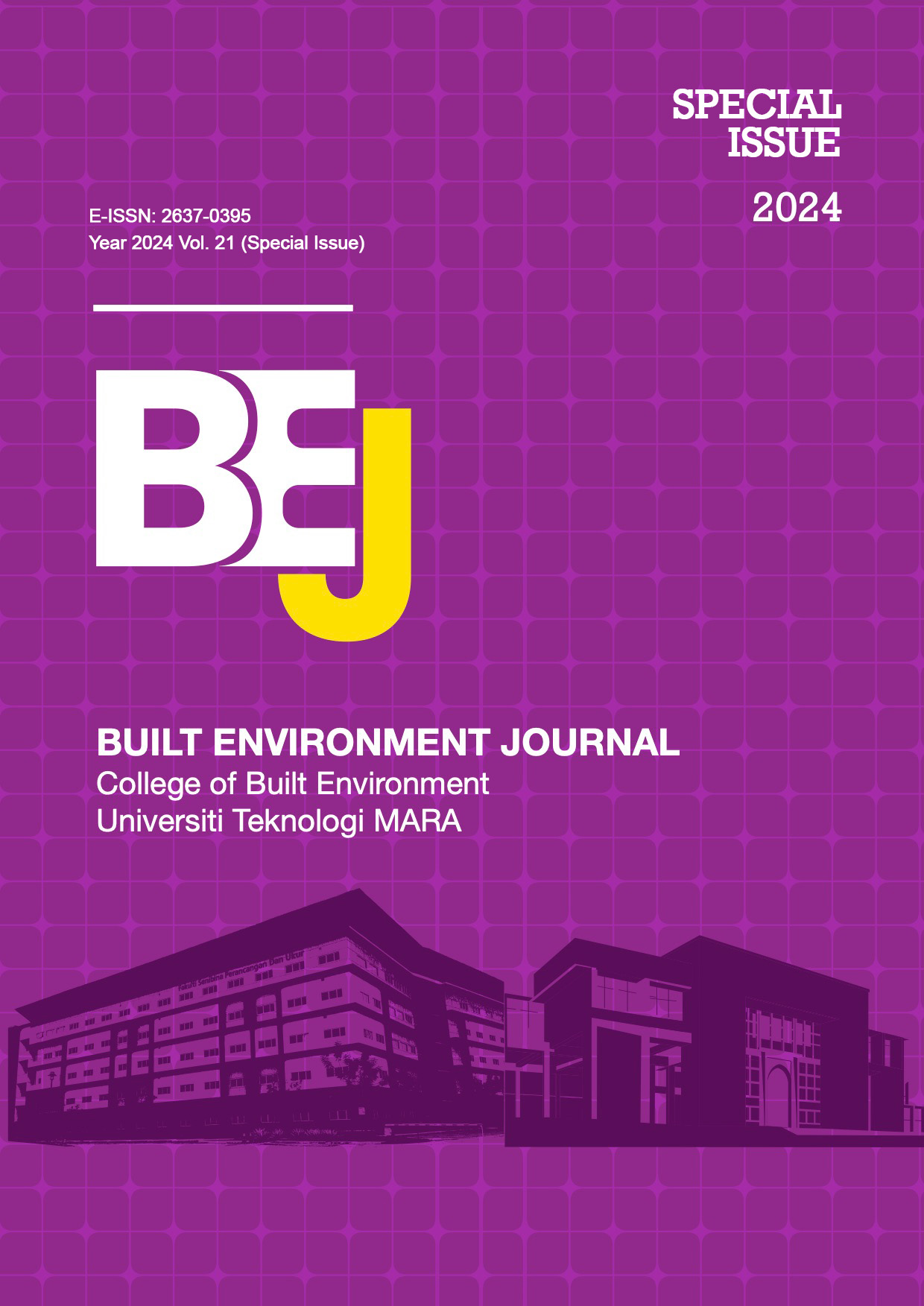Natural Environment Accessibility through Green Architecture in Malaysian Low-Cost Housing Development from Islamic Principles
DOI:
https://doi.org/10.24191/bej.v21iSI.2426Keywords:
Natural Environment, Green Architecture, Low-cost Housing, Green Rating Tool, Biophilic Theory, Islamic PrinciplesAbstract
Rapid urbanisation has led to an urgent need to enhance the quality of life in urban environments. The development of low-cost housing, often without sustainable design, has disconnected urban residents from nature, affecting the low-income population. This disconnection has increased over the past few decades, restricting natural human tendencies and reducing rights to a healthy living environment. To reconnect residents with nature and improve urban living conditions, low-cost housing developments should consider incorporating sustainable design and green architecture strengthened by respect to Islamic values as the significant element of Malaysian identity. The purpose of this paper is to emphasise the importance of accessibility to nature by highlighting a more comprehensive understanding of the significance of natural environment accessibility from the Islamic principles, particularly in low-cost housing development areas that have been planned with poorly built environments. The concept of biophilia which postulated that people have innate tendencies towards the natural environment poses an important foundation for green architecture approaches which later can be developed into a series of green building regulations and rating tools. In this study, these green rating tools are utilised to evaluate the significance of natural environment accessibility for developing low-cost housing through comparative analysis. From the literature review, comparative analysis and case study, it is found that the accessibility to the natural environment needs to be improved significantly in the low-cost housing project through involvement of various parties in built environment practices. By considering the Islamic viewpoint, which advocates for human roles in the preservation and conservation of natural environments, the purpose of this paper is to bring attention to the significance of aligning the translation of biophilic theory in green architecture through natural environment accessibility in low-cost housing in respect to Islamic values, upholding Malaysian identity as Islamic country.
References
Ahmad, A. (2020). The Role of Values in Social Change: An Analysis from The Qur’ānic Perspective. Al-Milal: Journal of Religion and Thought, 2(1), 1-36. https://doi.org/10.46600/almilal.v2i1.70
Al Farisi, S., & Ibadurrahman, Y. (2023). The Role of Zakat in Advancing Environmental Initiatives and Empowering Communities through a Green Economy-Based Approach. In Indonesian Conference of Zakat-Proceedings (pp. 743-759). https://doi.org/10.37706/iconz.2023.611. Retrieved from https://iconzbaznas.com/submission/index.php/proceedings/article/view/611
Ali, M. A., & Kamraju, M. (2023). Natural Resources and Society: Understanding the Complex Relationship Between Humans and the Environment. Springer Nature. https://doi.org/10.1007/978-3-031-46720-2
Alsheikh Mahmoud, S., Bin Hashim, H., Shamsudin, M. F., & Alsheikh Mahmoud, H. (2024). Effective Preservation of Traditional Malay Houses: A Review of Current Practices and Challenges. Sustainability, 16(11), 4773. https://doi.org/10.3390/su16114773
Andaya, L. Y. (2021). Trade, Ethnicity, and Identity in Island Southeast Asia. Oxford Research Encyclopedia of Asian History. https://doi.org/10.1093/acrefore/9780190277727.013.549
Browning, W. D., & Ryan, C. O. (2020). Nature inside: a biophilic design guide. Routledge. https://doi.org/10.4324/9781003033011
Calogiuri, G., Litleskare, S., & Fröhlich, F. (2021). Physical Activity and Virtual Nature: Perspectives on the Health and Behavioral Benefits of Virtual Green Exercise. Nature and Health, 127-146. https://doi.org/10.4324/9781003154419-10
Cardoso, R., Sobhani, A., & Meijers, E. (2022). The cities we need: Towards an urbanism guided by human needs satisfaction. Urban Studies, 59(13), 2638-2659. https://doi.org/10.1177/00420980211045571
Chiesura, A. (2004). The role of urban parks for the sustainable city. Landscape and urban planning, 68(1), 129-138. https://doi.org/10.1016/j.landurbplan.2003.08.003
Cooley, S. J., Jones, C. R., Kurtz, A., & Robertson, N. (2020). ‘Into the Wild’: A meta-synthesis of talking therapy in natural outdoor spaces. In Clinical Psychology Review (Vol. 77). https://doi.org/10.1016/j.cpr.2020.101841
D’Alessandro, D., Gola, M., Appolloni, L., Dettori, M., Fara, G. M., Rebecchi, A., Settimo, G., & Capolongo, S. (2020). COVID-19 and living space challenge. Well-being and public health recommendations for a healthy, safe, and sustainable housing. Acta Bio Medica: Atenei Parmensis, 91(9-S), 61. https://doi.org/10.23750/abm.v91i9-S.10115
Dadvand, P., & Nieuwenhuijsen, M. J. (2021). Urban Greenspace, Transportation, and Health. In International Encyclopedia of Transportation: Volume 1-7 (Vol. 7). https://doi.org/10.1016/B978-0-08-102671-7.10733-X
Dariah, A. R., Salleh, M. S., Yahaia, M. B., & Mafruhat, A. Y. (2019). Integrating Dimensions of Sustainable Development Goals (SDGs) Within Umranic Framework. https://doi.org/10.20944/preprints201908.0305.v1
Dariyadi, M. W., Baydoun, Z., Kamarudin, Z., & Murtadho, N. (2022). The Islamic art and design elements applied in the Islamic city. City, Territory and Architecture, 9(1), 10. https://doi.org/10.1186/s40410-022-00155-4
Ebrahiem Ebrahiem, E., Alaa Mandour, M., & Mostafa Sobhy, T. (2021). Creating healthy spaces indicators. Engineering Research Journal, 169, 1-15. https://doi.org/10.21608/erj.2021.152743
El-Hussieny, E. (2023). Design Solutions and Architectural Treatments to Achieve Thermal Comfort in the Interior Space of the Building. Resourceedings, 3(2). https://doi.org/10.21625/resourceedings.v3i2.977
ElSayed, S. (2023). Evaluating Islamic buildings according to standard sustainable design. International Journal of Advanced Engineering and Business Sciences, 4(3), 1-21. https://doi.org/10.21608/ijaebs.2023.191294.1077
Eph.jkr.gov.my (2015) Tatacara Pelaksanaan PH JKR Sektor Bangunan. In Manual Penarafan Hijau JKR (pH JKR)(Sektor Bangunan KB 2 Versi 2 pp. 14-15). Jabatan Kerja Raya Cawangan Alam Sekitar dan Kecekapan Tenaga. Retrieved September 18, 2024, from https://anyflip.com/gatnk/tuup/basic
Google. (2021). Google Earth Street View of PPR Desa Tun Razak, Cheras, Kuala Lumpur, Malaysia 3°04'44"N 101°42'58"E, camera 54M. Street view imagery. [Online] Available at: https://earth.google.com/web/search/PPR+Desa+Tun+Razak/@3.07910785,101.71628525,54.40697481a,0d,60y,164.96027071h,106.32611075t,0r/data=CiwiJgokCR79530eOjRAERz9530eOjTAGUATxeaYmTtAIWm9fgbviFLAQgIIASIaChZGbWk1VnY2ZUJOamFKXzRvdk5HU09REAI6AwoBMEoNCP___________wEQAA [Accessed September 18, 2024].
Google. (2023-a). Google Earth Satellite View of PPR Beringin, Jinjang Utara, Kuala Lumpur, Malaysia. 3°13'02"N 101°39'49"E, elevation 49M. 3D Buildings data layer. [Online] Available at: https://earth.google.com/web/search/PPR+Beringin/@3.21728292,101.66370405,48.61971576a,1325.51615298d,35.00000058y,0h,0t,0r/data=CiwiJgokCUYl3kZgpQhAET3EAKF4nQhAGUcz1sXrbVlAIbgSS7HNbVlAQgIIAToDCgEwSg0I____________ARAA [Accessed September 18, 2024].
Google. (2023-b). Google Earth Satellite View of PPR Desa Tun Razak, Cheras, Kuala Lumpur, Malaysia. 3°04'41"N 101°42'57"E, elevation 52M. 3D Buildings data layer. [Online] Available at: https://earth.google.com/web/search/PPR+Desa+Tun+Razak/@3.0783172,101.71595437,53.23900201a,845.19711957d,35y,0h,0t,0r/data=CoEBGlMSTQolMHgzMWNjMzVjYjQ4OGUwYjJmOjB4MTg1Yjc4MDk3ZjE3YWZiMBnpEy8FWqAIQCE7oXzm0W1ZQCoSUFBSIERlc2EgVHVuIFJhemFrGAIgASImCiQJHv3nfR46NEARHP3nfR46NMAZQBPF5piZO0Ahab1-Bu-IUsBCAggBOgMKATBKDQj___________8BEAA [Accessed September 18, 2024].
Google. (2023-c). Google Earth Street View of PPR Desa Tun Razak, Cheras, Kuala Lumpur, Malaysia. 3°04'44"N 101°43'01"E, camera 54M. Street view imagery. [Online] Available at: https://earth.google.com/web/search/PPR+Desa+Tun+Razak/@3.07910408,101.71719011,54.32050705a,0d,60y,265.60148857h,99.832691t,0r/data=CoEBGlMSTQolMHgzMWNjMzVjYjQ4OGUwYjJmOjB4MTg1Yjc4MDk3ZjE3YWZiMBnpEy8FWqAIQCE7oXzm0W1ZQCoSUFBSIERlc2EgVHVuIFJhemFrGAEgASImCiQJHv3nfR46NEARHP3nfR46NMAZQBPF5piZO0Ahab1-Bu-IUsBCAggBIhoKFmloSmhWS2daOGw0NGFpbXI5QzgxcXcQAjoDCgEwSg0I____________ARAA [Accessed September 18, 2024].
Greenbuildingindex.org (2009). Green Building Index Assessment Criteria for NRNC. In Green Building Index Assessment Criteria for NRNC (First Edition pp. 2–17). Greenbuildingindex Sdn Bhd. Retrieved September 18, 2024, from https://www.greenbuildingindex.org/Files/Resources/GBI%20Tools/GBI%20NRNC%20Non-Residential%20Tool%20V1.0.pdf
GreenRE.org (2024). Design Reference Guide for Residential Building & Landed Home (Version 3.3 pp. 1-9). Real Estate and Housing Developers' Association (REHDA) Malaysia Retrieved September 18, 2024, from https://www.greenre.org/assetuploads/files/RES_v3_3_r1(3).pdf
Gu, D., Andreev, K., & Dupre, M. E. (2021). Major trends in population growth around the world. China CDC weekly, 3(28), 604. https://doi.org/10.46234/ccdcw2021.160
Hady, S. I. M. A. (2021). Activating biophilic design patterns as a sustainable landscape approach. Journal of Engineering and Applied Science, 68(1). https://doi.org/10.1186/s44147-021-00031-x
Hakala, K. (2021). Biophilia & Urbanization. Sustaining and fostering Human–Nature connections for healthier urban density and sustainability. [Master’s thesis, Aalto University] Aalto University Learning Centre. https://aaltodoc.aalto.fi/items/dc03f77f-b9a1-4a06-af1e-79f1193a3763
Hossain, M. Z. (2018). Towards A Green World: an Islamic Perspective. International Journal of Contemporary Research and Review, 9(08), 20181-20193. https://doi.org/10.15520/ijcrr/2018/9/08/580
Ip, C. M. (2023). Urban living with nature: design for human-nature interactions in communal green spaces at residential high-rises. IOP Conference Series: Earth and Environmental Science, 588, 052002. https://doi.org/10.1088/1755-1315/588/5/052002
Jaffar, N., Harun, N. Z., & Abdullah, A. (2020). Enlivening the mosque as a public space for social sustainability of traditional Malay settlements. Planning Malaysia, 18(12). https://doi.org/10.21837/pm.v18i12.750
Kruize, H., van der Vliet, N., Staatsen, B., Bell, R., Chiabai, A., Muiños, G., & Stegeman, I. (2019). Urban green space: creating a triple win for environmental sustainability, health, and health equity through behavior change. International journal of environmental research and public health, 16(22), 4403. https://doi.org/10.3390/ijerph16224403
Lam, W. H., Wong, C. F., Tan, O. K., & Yap, B. H. (2024). Study on the Benefits of the Implementation of Green Building Rating in Malaysia. The Journal of The Institution of Engineers Malaysia, 85(1). https://doi.org/10.54552/v85i1.226
Luo, S., Xie, J., & Furuya, K. (2021). “We Need such a Space”: Residents’ Motives for Visiting Urban Green Spaces during the COVID-19 Pandemic. Sustainability, 13(12), 6806. https://doi.org/10.3390/su13126806
Mohamed, M. F. (2020). Sustainable design approaches in Malaysia’s traditional mosques and houses. In Proceeding International Conference on Engineering (Vol. 1, No. 1, pp. 13-21). https://doi.org/10.36728/icone.v1i1.1263
Mohamed, N. Y. (2018). The Role of the Qur’ānic Principle of Wasaṭiyyah in Guiding Islamic Movements. Australian Journal of Islamic Studies, 3(2), 21-38. https://doi.org/10.55831/ajis.v3i2.103
Monteiro, R., Ferreira, J. C., & Antunes, P. (2020). Green infrastructure planning principles: An integrated literature review. Land, 9(12), 525. https://doi.org/10.3390/land9120525
Muhamad, A., Syihab, A. H., & Ibrahim, A. H. (2020). Preserving human–nature’s interaction for sustainability: Quran and Sunnah perspective. Science and engineering ethics, 26(2), 1053-1066. https://doi.org/10.1007/s11948-020-00192-7
Nouman, M., Siddiqi, M. F., Ullah, K., & Jan, S. (2021). Nexus between higher ethical objectives (Maqasid Al Shari’ah) and participatory finance. Qualitative Research in Financial Markets, 13(2), 226-251. https://doi.org/10.1108/QRFM-06-2020-0092
Nursanty, E., & Wulandari, A. (2023). Unveiling The Authenticity of Islamic Values: The Evolution and Transformation of Traditional Villages. Journal of Islamic Architecture, 7(4). https://doi.org/10.18860/jia.v7i4.21258
Ogunbado, A. F., & Darussalam, B. (2020, December). Religious Quest for Sustainable Development: An Islamic Standpoint. In ICIC 2020: Proceedings of the 1st International Conference on Islamic Civilization, ICIC 2020, 27th August 2020, Semarang, Indonesia (p. 119). European Alliance for Innovation. https://doi.org/10.4108/eai.27-8-2020.2303276
Padawangi, R. (2023). Southeast Asian cities: The imbalances of urban development. In Routledge Handbook of Asian Cities (pp. 303-317). Routledge. https://doi.org/10.4324/9781003256533
Parida, S., Ananthram, S., Chan, C., & Brown, K. (2021). Green office buildings and sustainability: Does green human resource management elicit green behaviors?. Journal of Cleaner Production, 329, 129764. https://doi.org/10.1016/j.jclepro.2021.129764
Pineo, H. (2022). Healthy urbanism: designing and planning equitable, sustainable and inclusive places. Springer Nature. https://doi.org/10.1007/978-981-16-9647-3
Puhakka, R. (2021). University students’ participation in outdoor recreation and the perceived well-being effects of nature. Journal of Outdoor Recreation and Tourism, 36, 100425. https://doi.org/10.1016/j.jort.2021.100425
Richardson, M., & Butler, C. W. (2022). Nature connectedness and biophilic design. Building Research & Information, 50(1-2), 36-42. https://doi.org/10.1080/09613218.2021.2006594
Ridho, M. I., & Wibowo, S. E. (2023). Relationships of Human, Religion and Nature in Yusuf Qardawi's Perspective. Islamuna: Jurnal Studi Islam, 10(1), 1-18. https://doi.org/10.19105/islamuna.v10i1.8723
Rietveld, M. (2024). The Natural In-Between Place for Stress Relief through Biophilic Design. [Master’s thesis, TU Delft Campus] TU Delft Research Repository. https://repository.tudelft.nl/file/File_917f5b93-4556-419f-89a8-5cb64c719e03?preview=1
Riva, G., Wiederhold, B. K., & Mantovani, F. (2021). Surviving COVID-19: the neuroscience of smart working and distance learning. Cyberpsychology, Behavior, and Social Networking, 24(2), 79-85. https://doi.org/10.1089/cyber.2021.0009
Ryan, C. O., Browning, W. D., Clancy, J. O., Andrews, S. L., & Kallianpurkar, N. B. (2014). Biophilic design patterns: emerging nature-based parameters for health and well-being in the built environment. ArchNet-IJAR: International Journal of Architectural Research, 8(2), 62. https://doi.org/10.26687/archnet-ijar.v8i2.436
Ryan, C.O. & Browning, W.D. (2020). Biophilic Design. In: Loftness, V. (eds) Sustainable Built Environments. Encyclopedia of Sustainability Science and Technology Series. Springer, New York, NY. https://doi.org/10.1007/978-1-0716-0684-1_1034
Saiyed, Z., & Irwin, P. D. (2017). Native American storytelling toward symbiosis and sustainable design. Energy Research & Social Science, 31, 249-252. https://doi.org/10.1016/j.erss.2017.05.029
Sarkar, C., Webster, C., & Gallacher, J. (2018). Residential Greenness and Prevalence of Major Depressive Disorders: A Cross-Sectional, Observational, Associational Study of 94 879 Adult UK Biobank Participants. Lancet Planet. Health , 2, 162–173. https://doi.org/10.1016/S2542-5196(18)30051-2
Sayem, M. A. (2021). Eco-Religious Teachings and Environmental Sustainability:An Analysis of Workability of Seyyed Hossein Nasr’s ‘Eco-Spirituality’ in the Context of Bangladesh. Australian Journal of Islamic Studies, 6(3), 69-83. https://doi.org/10.55831/ajis.v6i3.357
Setia, A. (2016). The Meaning of “Economy”: Qasd, Iqtisad, Tadbir Al-Manzil. Islamic Sciences, 14(1), 117. https://www.questia.com/library/journal/1G1-459507054/the-meaning-of-economy-qasd-iqtisad-tadbir-al-manzil.
Silvern, S. E. (2021). The Jewish Food Movement: A Sustainable and Just Vision for Place, Identity, and Environment. In Religion, Sustainability, and Place (pp. 327-354). Palgrave Macmillan, Singapore. https://doi.org/10.1007/978-981-15-7646-1_14
Solla, M., Milad, A., Hakim, L., Shaarani, A., Yusoff, N. I. M., & Abass, F. (2020, November). The application of building information modelling in green building index for energy efficiency assessment. In 2020 Second International Sustainability and Resilience Conference: Technology and Innovation in Building Designs (51154) (pp. 1-5). IEEE. https://doi.org/10.1109/IEEECONF51154.2020.9320002
Stanley, M. C., & Galbraith, J. A. (2024). Connecting people with place-specific nature in cities reduces unintentional harm. Environmental Research: Ecology, 3(2), 023001. https://doi.org/10.1088/2752-664X/ad3f22
Tabb, P. J. (2020). Biophilic urbanism: Designing resilient communities for the future. Routledge. https://doi.org/10.4324/9781003034896
Tedong, P. A., & Zyed, Z. A. S. (2022). Searching for sustainable cities: residents’ perceptions on the implementation of sustainable cities in Malaysia. Community Development Journal, 57(1), 112-131. https://doi.org/10.1093/cdj/bsab040
Ulrich, R. S., Cordoza, M., Gardiner, S. K., Manulik, B. J., Fitzpatrick, P. S., Hazen, T. M., & Perkins, R. S. (2019). ICU Patient Family Stress Recovery During Breaks in a Hospital Garden and Indoor Environments. HERD Health Environments Research & Design Journal, 13(2), 83–102. https://doi.org/10.1177/1937586719867157
Wan Ali, W. N. A., Hassan, N., Abdullah, M., Ismail, M., & Johari, N. (2020). An analytical study of mosques and public spaces: Integration space for spiritual and community bonding. In Charting a Sustainable Future of ASEAN in Business and Social Sciences: Proceedings of the 3ʳᵈ International Conference on the Future of ASEAN (ICoFA) 2019—Volume 1 (pp. 237-252). Springer Singapore. https://doi.org/10.1007/978-981-15-3859-9_22
Wanjiru, E., & Xia, X. (2018). Sustainable energy-water management for residential houses with optimal integrated grey and rain water recycling. Journal of cleaner production, 170, 1151-1166. https://doi.org/10.1016/j.jclepro.2017.09.212
Wells, W., & Vermeer, K. (2020). Blueprint for greening affordable housing. Island Press. https://doi.org/10.1080/02673037.2021.1983155
Wen, L., Kenworthy, J., & Marinova, D. (2020). Higher density environments and the critical role of city streets as public open spaces. Sustainability, 12(21), 8896. https://doi.org/10.3390/su12218896
Xiang, P., Yang, Y., & Li, Z. (2020). Theoretical framework of inclusive urban regeneration combining nature-based solutions with society-based solutions. Journal of Urban Planning and Development, 146(2), 04020009. https://doi.org/10.1061/(ASCE)UP.1943-5444.0000571
Yaacob, M. A., & Hassan, N. Z. A. P. (2024). Exploring the Challenges Faced by the Urban Squatter Dwellers in Sentul, Kuala Lumpur, Malaysia. Journal of Population and Social Studies [JPSS], 32, 14-35. http://doi.org/10.25133/JPSSv322024.002
Yasin, M. Y., Zain, M. A. B. M., & Hassan, M. H. B. (2022). Urbanization and growth of Greater Kuala Lumpur: Issues and recommendations for urban growth management. Southeast Asia: A Multidisciplinary Journal, 22(2), 4-19. https://doi.org/10.1108/SEAMJ-02-2022-B1002
Zhou, X., & Rana, M. P. (2012). Social benefits of urban green space: A conceptual framework of valuation and accessibility measurements. Management of Environmental Quality: An International Journal. https://doi.org/10.1108/14777831211204921
Downloads
Published
Versions
- 01-05-2025 (2)
- 31-12-2024 (1)
How to Cite
Issue
Section
License
Copyright (c) 2024 Azlan Ariff Ali Ariff, Mohamad Faris Ismi , Mohd Tajul Izrin Mohd Tajul Hasnan, Wan Mohammad Zaeim Wan Mahadi, Mohd Syafiq Azmy, Siti Aishah Ramli, Nur Ulfah Awatif Umairah Alias

This work is licensed under a Creative Commons Attribution-NonCommercial-NoDerivatives 4.0 International License.
CC BY-NC-ND 4.0 DEED
Attribution-NonCommercial-NoDerivs 4.0 International












